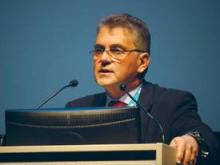AMSTERDAM – Another investigational lung cancer vaccine did not improve overall survival, although its use might still benefit some patients, according to results of a phase III study presented at the multidisciplinary European cancer congresses.
The therapeutic tumor cell cancer vaccine belagenpumatucel-L (Lucanix) was no better than placebo at improving the primary endpoint of overall survival after frontline, platinum-based chemotherapy in the STOP study. A total of 532 patients with stable stage III or IV non–small cell lung cancer (NSCLC) participated in the study.
Median overall survival was 20.3 months in the vaccinated patients and 17.8 months in those who had received placebo over a 2-year period (hazard ratio, 0.54; P = .0595).
There was an indication that overall survival might be improved, however, if patients were given the vaccine within 12 weeks of stopping their frontline chemotherapy. Indeed, overall survival was 20.7 months in 169 patients who were vaccinated within 12 weeks of stopping chemotherapy versus 13.3 months in 149 patients who did not receive the vaccine until after that time (HR, 0.77; P = .0092).
"Prospective subset data support further development of belagenpumatucel-L in NSCLC," said Dr. Giuseppe Giaccone, the presenting investigator and associate director of clinical research at the Lombardi Comprehensive Cancer Center at Georgetown University, Washington.
Dr. Giaccone said that the trial was not appropriately powered to meet its primary endpoint. The trial design presumed that the placebo-treated patients would achieve a median survival of around 10.5 months, which was the norm at the time the trial was conceived.
The somewhat disappointing findings in the STOP trial follow those of the phase III START trial, which found no overall survival benefit with a different investigational lung cancer vaccine, tecemotide (Stimuvax). Development of tecemotide also continues, however, as there was an indication that the vaccine might work if given concurrently with chemoradiation rather than after it. The START2 trial will be investigating that hypothesis.
The STOP trial was a randomized, double blind, placebo-controlled investigation performed in eight countries that ran for 46 months and involved patients with late-stage NSCLC; 490 patients had stage IIIB/IV cancer and 42 had stage IIIA cancers. Patients could be enrolled in the trial if they had stable disease after up to six cycles of platinum-based chemotherapy. The aim of the study was to determine if vaccination with belagenpumatucel-L could prevent progression after successful first-line chemotherapy.
Belagenpumatucel-L consists of four allogeneic NSCLC cell lines that have been modified to express an antisense DNA molecule that binds to the gene responsible for producing transforming growth factor beta (TGF-beta), thus blocking production of the protein. TGF-beta has immunosuppressive properties and helps tumor cells evade immune defenses. During the study, the vaccine was given as 18-month intradermal injections followed by a further two injections given 3 months apart. Each dose contained 2.5 × 107 cells.
"Overall, the response rate to the vaccination was low, at 2.6%," Dr. Giaccone reported. There were only one (0.4%) complete and six (2.2%) partial responses. "Progression-free survival did not correlate with overall survival, and there was a trend in some of the subgroups toward an improved PFS, but this was not statistically significant."
The most common side effects were injection-site reactions (grade 1-2), occurring in 260 of the vaccinated and 62 of the placebo-treated patients. Unexpected effects included abdominal pain, constipation, decreased appetite, nasopharyngitis, and noncardiac chest pain, all affecting more patients who received belagenpumatucel-L than those who received placebo. Five serious adverse events occurred, three of which were in patients treated with the vaccine, and only one of these, an allergic reaction, was probably due to the vaccine itself.
NovaRx sponsored the study. Dr. Giaccone said he had no conflicts of interest but noted his coinvestigators included employees of NovaRx.


